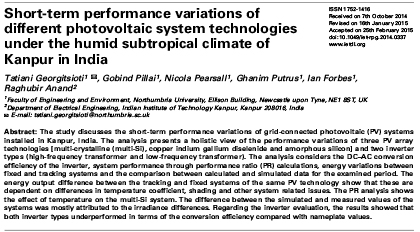The paper analyses the energy percentage difference between the tracking and fixed structure PV systems and the daily PR for the systems installed at the IIT-Kanpur. It has been observed that the energy percentage difference is significantly lower than the simulated value acquired by PVSyst for two of the technologies. This may be partially attributed to temperature effects. shading. inverter matching and module tolerances. However. it is shown that the difference between the simulated and measured values of the systems was mostly because of the difference in irradiation values.
The effect of temperature on the PR is observed for multi-Si at high irradiation levels. whereas the thin film technologies do not show a decrease under these conditions. Nevertheless. the multi-Si system was the most stable technology in terms of performance during the examined period since it provides a good match between the expected and the calculated results. Regarding the inverter evaluation. the results showed that although the inverters met the Indian standards. both inverter types underperformed in terms of the conversion efficiency at the experimental location. For the low-frequency transformer type inverter. which is connected with the CIGS system. an issue with the inverter threshold was revealed from the short-term analysis.
 Iran Energy News Oil, Gas, Petrochemical and Energy Field Specialized Channel
Iran Energy News Oil, Gas, Petrochemical and Energy Field Specialized Channel




